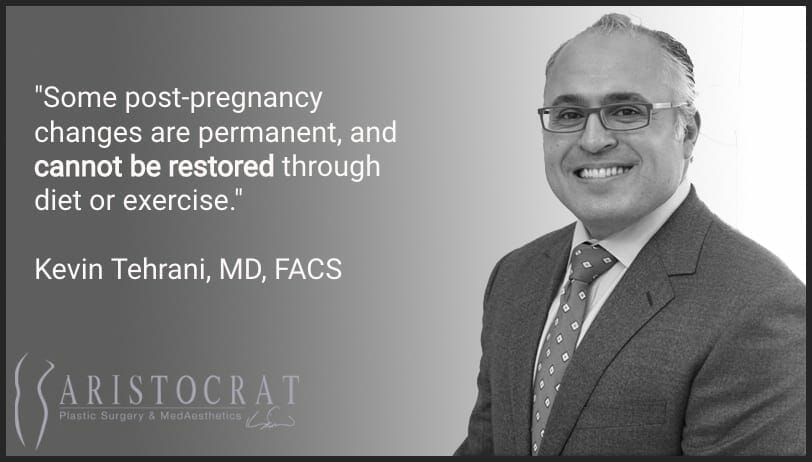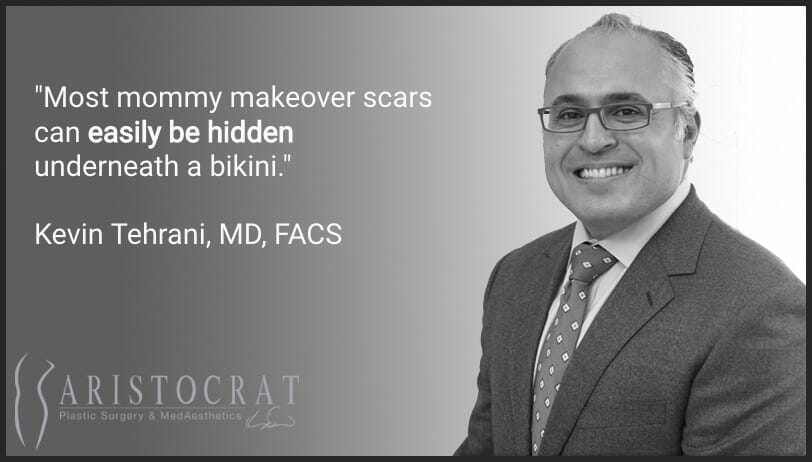Mommy Makeover Scars: How Bad Are They?
For new moms, the mirror is often no longer their friend. The pregnancy is ruthless on a woman’s body, causing changes that cannot be reversed through exercise or dieting. Today, there’s a solution: a complete mommy makeover. But just how bad are the scars?
Pregnancy is tough on your body. During those 9 months of childbearing and the following period of breastfeeding, your body undergoes a number of transformations—often times, these transformations do not leave women satisfied with their look in the mirror.

Mommy makeover, once a taboo procedure, is becoming revolutionary popular today. The procedure involves breast lift/augmentation, tummy tuck (abdominoplasty), liposuction and, occasionally, labiaplasty. These are all elective procedures, and each mommy makeover is tailored towards the patient’s specific measurements and needs.
Here’s an insight into how common mommy makeover procedures have become over the years:
- In 2017, a total of 300,378 breast augmentations were performed – a 41 percent increase since 2000.
- In 2017, there were 105,219 breast lifts (mastopexies) performed – nearly double the amount done in 2000.
- In the past 17 years, tummy tucks (abdominoplasties) have seen a 107 percent increase – more than double the amount performed compared with 2000. A total of 129,753 were done in 2017, compared with 62,713 in 2000.
What Does a Mommy Makeover Do, and Why Should You Go for It?
With every surgery, it’s important to have clear expectations on what’s possible and what can you expect. With a group of procedures as major as mommy makeover, managing your expectations is that much more important.
Contrary to a popular belief, a mommy makeover cannot magically turn back time to your pre-baby days within weeks after the procedure. It simply wouldn’t be safe, or bear satisfactory results. The reason is simple: your body is still very much changing during the first 6 months after pregnancy, and breast-lift, one of the mommy makeover procedures, is not performed on breast-feeding mothers.
Pregnancy and childbirth cause immense stress for the mother, which means that you’d be in a weakened state going into the surgery. This means you won’t be able to recover as fast, meaning you won’t be able to look after the baby for longer and increase the risk of complications (including significant scarring.)

Dr. Tehrani always recommends at least 6 months of downtime after childbirth before undergoing cosmetic surgery. This time frame gives enough room for your abdomen muscles and skin to recover naturally into a more permanent state. Performing surgery before the end of the 6-month break means that the results may very well be counteracted by your natural body changes.
But, still, you see all those celebrities on magazine covers—who seem to get back into shape within months after childbirth. How do they do that?
A combination of several techniques goes into restoring your body quickly after pregnancy.
First of all, they work closely with their physicians and dietologists during pregnancy. By keeping their diet clean and engaging in light, but regular exercise, they keep their bodies relatively in shape even while bearing a child.

Most pregnant women use their condition as an excuse to stuff their faces with high-calorie foods and skip workouts. Then they look in the mirror, greeted by a body affected not only by hormonal changes, but poor diet and low activity too.
All the weight you gain from calorie intake during pregnancy, you’ll still have to lose in order to get into shape.
Gaining excessive weight during pregnancy is also dangerous since you’ll end up with a lot of loose skin once you’ll start losing weight and undergoing cosmetic surgery. Tummy tuck, a part of the mommy makeover complex, takes care of that, removing the excess skin. Still, it’s a much easier transition if you simply do not let yourself go during those 9 months.
Celebrities also know that breastfeeding burns a surprising amount of calories. Simply by breastfeeding your baby you’ll lose a healthy portion of the weight you’ve gained during pregnancy.
There are some things, however, which cannot be achieved purely through diet and exercise for pregnant women. For example, pregnancy hormones force the body to store additional fat deposits. These deposits do not respond to diet or exercise and usually end up equipping mothers with brand new love handles. These love handles can only be removed surgically.

Pregnancy also causes significant skin stretching and damage to the abdomen muscles. As your belly grows to accommodate the baby, your abdomen muscles are stretched immensely—sometimes, to extremes. This affects skinny and fat women alike. The newly found pregnancy belly isn’t just unaesthetic—it also puts additional pressure on your back.
There’s no exercise regimen that could restore your abdomen muscles to their previous state fully. Instead, a surgeon’s hand is needed to tighten the abs once again.
After breastfeeding, some mothers end up with breast significantly smaller in volume and drooping downwards. Mommy makeovers always involve breast lifts and, sometimes, a breast augmentation as well to solve this issue.
Which Procedures Does a Mommy Makeover Involve? How Bad Are The Scars?
Mommy makeover is a set of several procedures that will be adapted to your particular needs. Not all women need to perform all of the procedure in order to restore their pre-birth appearance (and even better than that.) For most women, one or two procedures will do the trick.
The only way to know for certain which procedures would benefit you the most is to talk to a board-certified surgeon like Dr. Tehrani. With that in mind, here’s the list of mommy makeover procedures.

Breast Lift
Breast lift is an essential element of the mommy makeover, as many new moms aged between 30-40 see significant drooping and shrinking of the breasts. Often times, during pregnancy, the breasts may increase in size several times, only to shrink after the mother is done breastfeeding.
As the breasts grow larger to accommodate all the milk, the skin is stretched significantly. This translates directly into a droopy appearance after the breasts shrink (when the mother stops breastfeeding.) Basically, if your nipples are pointed south, you’d probably benefit greatly from a breast lift procedure.
Breast Lift Scars
Both breast lift and breast reduction procedures require incisions. When the incisions heal, scar tissue forms, creating a highlighted appearance on the skin—the scar.
Should you be worried, though?
There are several important things to keep in mind:
- Breast lift scars are really easy to hide. The scars will either appear as small incisions on top of your breast (if the vertical “lollipop” technique is chosen) or thin horizontal incisions. Either way, they’re really easy to cover with a bra or a swimsuit.
- Scars fade away with time. Even though the scarring is somewhat permanent, they do fade away with time. Usually, it takes about 1-2 years before the scar becomes barely noticeable. Do not panic if you see any scarring pictures that were taken right after the procedures—most breast lift patients are extremely happy with their appearance as time goes by.
- A lot depends on the scope of the procedure. How much visible scarring is going to remain after the procedure depends on a number of factors, including how much sagging is there, how elastic your skin, and the overall scope of the lift. The general rule of thumb is this: the smaller the procedure, the less noticeable the scars.
- There are things you can do to minimize scars. While we’ll cover this in-depth further in this article, keep in mind that there are preparation and recovery guidelines that can significantly impact how well you heal after your procedure, potentially minimizing the scarring.
- Good surgeons will provide the best “value-for-scar.” Every patient is different, and we celebrate that. Here at Aristocrat Plastic Surgery, we strive to hear every single patient and truly understand their appearance goals. Sometimes, patients who believe a breast lift would be the optimal procedure for them to change their minds. Whatever the conclusion, we understand that significant scarring is an unacceptable outcome for most patients.
Breast Augmentation (Optional)
Some women choose to have their breasts enlarged after pregnancy. This makes sense for two reasons:
- Breasts do often shrink in size after breastfeeding
- If you’re going for surgery anyway, might as well add a little volume where it counts
If you’re unfamiliar with the procedure, here’s how it goes:
- Anaesthesia is administered to make the area under surgery numb to pain. Usually, a combination of local anaesthesia and general anaesthesia is used, depending on the extent of the procedure, patient’s preferences and other factors.
- Incisions are made in any 3 areas of choice, it can be:
- Inframammary incision which is a cut of about 1-2 inches long made underneath the breast in the crest area. This type of incision gives the surgeon enough room to place larger silicone gel implants with a high degree of accuracy in the breast.
- Periareolar incision is a cut made in the areola (the skin around the nipple) region of the breast. This type of incision does not make the scar visible, but it reduces the sensitivity of the nipples.
- Trans-axillary incision is a cut made in the armpit through which implants are inserted into the breast. This is done using an endoscope which is a tool with a camera and surgical instruments at the end. This leaves a visible scar in the armpit. The advantage of this type of cut is that it there’s no scar around the breast region.
- The breast implant is inserted through the incision in two ways:
- Submuscular Placement: the breast implant is implanted in a pocket under the pectoral muscle.
- Sub-mammary Placement: the breast implant is implanted in a pocket above the pectoral muscle, directly behind the mammary tissue.
Breast Augmentation Scars
Since there are several types of incision techniques used in breast augmentation, the scars will be different from procedure to procedure. An inframammary incision, the most popular one, is made right under the breast. The location of the incision makes it easy to hide the scars under a bikini.
With periareolar incisions, the cuts are made around the lower half of the areola—the skin around the nipple. Again, really easy to hide under a bikini.
Trans-axillary incisions are made in the armpit, which means there will be no scars on your breasts. These incisions, however, require more subtlety on the surgeon’s part, as it is more difficult to place the implant properly via the underarm incision.
Throughout your recovery, it is important to remember that the scars usually fade completely within 18 months—to a point where they’re barely noticeable. It also occurs that with scars, things often get worse before they get better. The scars become can red and swollen during the first few weeks of recovery, only to fade gradually over the course of the following months.
Age, genetics and skin laxity also play a role in how soon your scars will heal.
Tummy Tuck
Tummy tuck, also known as abdominoplasty, is one of the biggest plastic surgeries done today in terms of scope. During the procedure, a large incision is made horizontally across your abdomen. The surgeon then proceeds to tighten your abdomen muscles, remove stubborn fat pockets and excess skin.
Here’s how the procedure goes:
- General anaesthesia is administered to the patient to induce numbness and sleep.
- The surgeon makes two incisions:
- The first incision is an incision made near the pubic region from the hip bone on one side of the body to the hip bone on the other side of the body.
- The second incision is made around the belly button.
- The skin is separated from the stomach muscles
- The stomach muscles are tightened by pulling them in place and stitching them. This reduces the waistline and makes the abdomen firmer.
- A drainage tube is placed under the skin which is later removed.
- Excess skin is removed after the separated flap of skin is pulled over the tightened muscles.
- The belly button is reattached.
- The incisions are sutured.
- The area is dressed using sterile dressing.
This procedure usually takes between 2-5 hours to perform.
Tummy Tuck Scars
Out of all mommy makeover procedures, tummy tuck is the one that’s going to leave the largest scar. No matter how skilled the surgeon, an incision this large will leave a scar.
Before the procedure, we recommend you discuss this issue with Dr. Tehrani. Depending on your particular surgery, you may end up with a U or V-shaped scar. During your consultation, the doctor will always mark the incision line on your body so that you can where the scar will be in relation to your waistline.
Liposuction
Liposuction is frequently done in combination with other mommy makeover procedures. During the procedure, a small incision is made into a targeted fat pocket. Through the incision, a small tube called cannula is inserted. The fat deposits are then distorted via manual movement of the cannula and “suctioned” out through the tube.
Liposuction is a great way to deal with those love handles that so often form during the hormonal storms of pregnancy. However, abdomen is not the only area where liposuction can be performed.
Here are a few common areas for effective liposuction:
- Hips
- Abdomen (belly fat, love handles)
- Thighs (both inner and outer thighs)
- Buttocks (mommy butt)
- Back (folds of fat on the back)
- Arms (“hanging” underarm fat)
- Face (double chin)
Liposuction Scars
Through the mommy makeover cycle, liposuction is going to leave the smallest scars.
Since only tiny incisions are required for liposuction, the scars are barely noticeable, easily hidden under the clothes and heal quickly.
How To Minimize Mommy Makeover Scars
Luckily, there are things you can do to minimize scarring left over from your mommy makeover cycle.
- Go With a Surgeon You Can Trust
While this goes without saying, choosing the right surgeon for the job is the most important factor in how well your scars will heal.
The obvious reason is the knowledge and skill in the procedures. An experienced surgeon use a technique that will minimize the scarring and help you achieve the desired appearance.
But there are other, more subtle differences between surgeons—ones that we don’t like to talk about often.
Some practices will take on patients despite whether they’re a good candidate for the particular procedure or not—they will simply try to “sell” them the most expensive procedure, even at a cost of a possible complication or severe scarring.
While not all of those types of surgeons are necessarily ill-minded, some will simply not have the “luxury” to say no to a patient—even if the procedure could clearly harm them.
That is why we always suggest talking to at least several different plastic surgeons and evaluate their attitudes and level of commitment.
Signs of a good plastic surgeon include:
- Genuine interest in your goals and expectations
- Thorough interest in your medical history
- Honest, critical opinion about what types of procedures would work best for you
- Transparency in talking about previous patient cases and experience
- Patience and calmness—avoid surgeons who seem overworked and in a rush
- Sports Bras and Compression Garments
Generally, we recommend some type of compression apparel after all invasive procedures, as they help reduce the swelling around the incision site, speeding up recovery.
While under slight pressure, the lymphatic system can better flush out fluid and tissue buildups underneath the skin that form frequently after an invasive procedure.
If untreated, these tissues can morph into small lumps, causing fibrosis, a condition that could cause bruising and swelling to occur.
- Take it Easy
Be extremely cautious about your activities throughout several weeks after your breast lift procedure.
Straining your muscles and ligaments in the chest area is one of the more common post-surgical complications.
While patients know better than to straight-up stretch their chest area, they sometimes engage in other activities, which they think do not involve the chest muscles.
In reality, many lifting exercises involve stretching of the chest at least to an extent, and should be avoided.
Cardio, while not threatening to strain your muscles, can slow down the healing of the incisions due to natural movement, and should be limited as well.
The general rule of thumb is this: anything that makes you sweat should be avoided for at least a couple of weeks.
Based on your individual procedure and body parameters, your surgeon will prescribe a more detailed exercise and activity plan.
- Smoking Is a Big No-No
You’ve probably heard this countless times, but smoking is really, really bad for you during the recovery period.
The main reason why surgeons strictly forbid smoking for several weeks is because it significantly interferes with the healing processes. Which means, your scars are likely to be worse when you smoke.
What is more, sub-optimal healing may lead to complications, such as infection, which may cause worse problems than just a small scar.
If you think you can’t refrain from cigarettes for that long, we’d recommend to reconsider going under the knife, or exploring the non-invasive options.
Final Verdict: Some Scarring Is to Be Expected, But It’s Easily Hidden
If you do decide to go through with the full range of mommy makeover procedures, some scarring is definitely to be expected.
However, surgeons have learned to make these scars as small as possible and as easily hidden as possible:
- A tummy tuck incision is made below the patient’s panty line
- A breast lift/augmentation incision will be under the breast or in the armpit
- A liposuction scar is extremely small and difficult to notice even when it’s not covered

